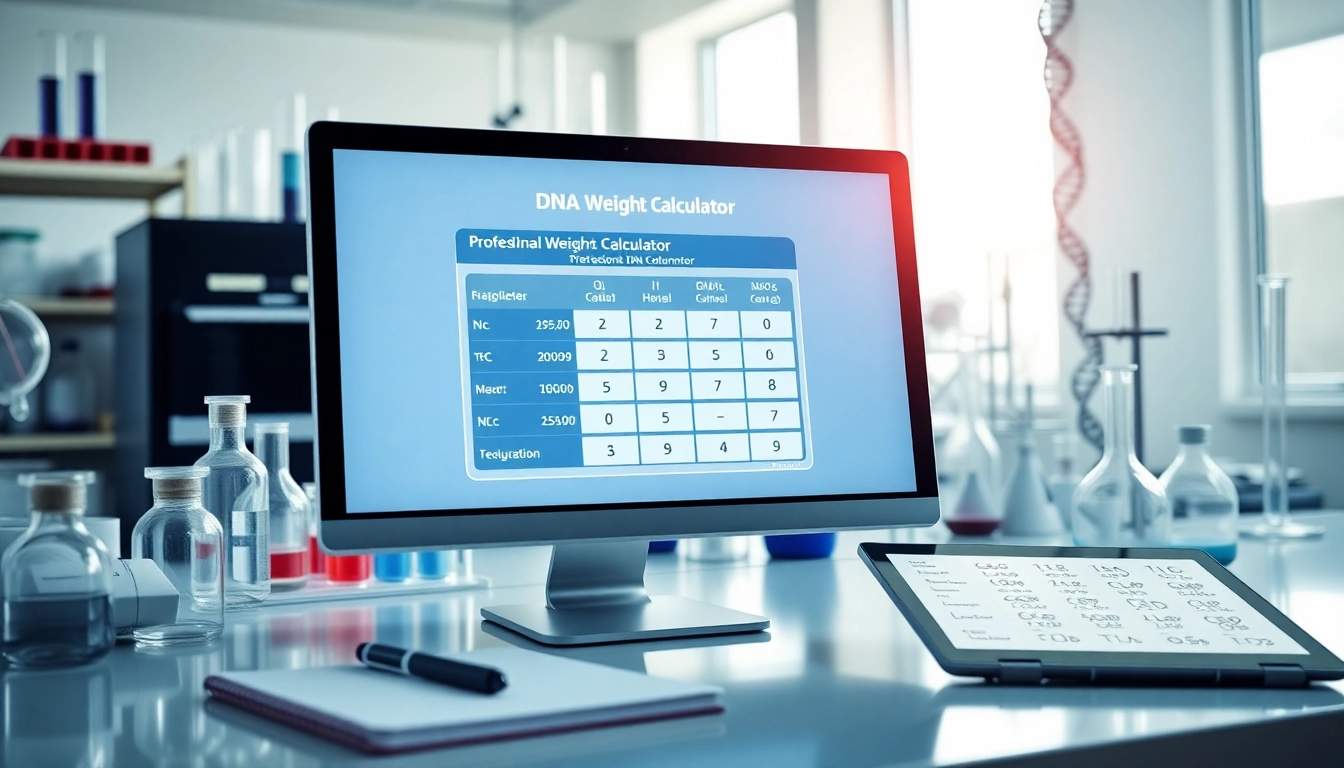Understanding the DNA Molecular Weight Calculator
The DNA Molecular Weight Calculator is an essential tool for researchers, geneticists, and molecular biologists. Understanding how to calculate the molecular weight of DNA is crucial for various applications in genetic research, including cloning, sequencing, and analysis. In this article, we delve deep into the concept of molecular weight in DNA, the significance of these calculations, the functionality of various calculators, and best practices for obtaining accurate results.
What is Molecular Weight?
Molecular weight refers to the mass of a molecule, typically expressed in daltons (Da) or grams per mole (g/mol). In the context of nucleic acids, molecular weight is a representation of the mass of the molecule based on the sequence of nucleotides it comprises. Each nucleotide in DNA consists of a sugar, a phosphate group, and a nitrogenous base (adenine, thymine, cytosine, or guanine). The molecular weight varies depending on the number and types of nucleotides present in the DNA strand.
The average molecular weight of a single base pair of DNA is approximately 650 daltons. Therefore, to determine the molecular weight of a DNA molecule, the total number of base pairs (bp) in the strand must be calculated and then multiplied by this approximate value.
Relevance of DNA Molecular Weight in Research
The molecular weight of DNA plays a crucial role in various applications in molecular biology and genetics, including:
- Quantification: Knowing the molecular weight allows for the conversion between the amount of DNA in moles and mass, facilitating accurate DNA quantification for experiments.
- Cloning and Ligation: Accurately calculating the amounts of DNA ensures effective ligation reactions and preparations of DNA constructs.
- Sequencing: Understanding the molecular weights helps in generating libraries for sequencing, where precise DNA amounts are critical for downstream applications.
- Genomics: Molecular weight calculations support comparative studies among different organisms, genetic variations, and gene expression levels.
Components of the DNA Molecular Weight Calculator
A robust DNA Molecular Weight Calculator typically consists of several components that facilitate accurate calculations:
- Input Fields: These fields accept raw DNA sequences in various formats including plain text, FASTA, or FASTQ formats.
- Parameters for Adjustments: Some calculators allow users to adjust parameters for specific nucleotides or modifications to calculate custom molecular weights.
- Output Display: Results are typically displayed clearly, showing the calculated molecular weight along with additional related information.
- Help and Support: User assistance features such as tooltips, FAQs, or video guides help users navigate the tool effectively.
How to Use the DNA Molecular Weight Calculator
Step-by-Step Instructions
Using the DNA molecular weight calculator is straightforward. Here’s how you can effectively use this tool:
- Access the Calculator: Visit the DNA Molecular Weight Calculator webpage.
- Input the Sequence: Copy and paste your DNA sequence into the provided input field. Make sure your sequence is complete and correctly formatted.
- Adjust Parameters: If needed, adjust any optional parameters such as concentration or specific nucleotides.
- Calculate: Click on the ‘Calculate’ button to obtain the molecular weight of your DNA strand.
- Review Results: Examine the output, which typically includes the molecular weight in g/mol and other relevant details.
Input Formats and Requirements
Input formats for DNA sequences can vary by calculator. Most calculators accept:
- Plain Text: Sequences entered directly into the input box.
- FASTA Format: Sequences starting with a ‘>’ followed by a header line and the sequence itself on subsequent lines.
- FASTQ Format: Similar to FASTA but includes quality scores.
Ensure that the sequence does not contain any unwanted characters or spaces, as these may cause errors in the calculation.
Troubleshooting Common Issues
Users may encounter issues while using the DNA Molecular Weight Calculator. Here are some common problems and their solutions:
- Invalid Input: Ensure that your DNA sequence is correctly formatted, with no extra spaces or invalid characters.
- Calculation Errors: If the calculator displays unexpected results, double-check your inputs and any user-defined parameters.
- Output Issues: If the results do not display correctly, try refreshing the webpage or using a different browser.
Applications of DNA Molecular Weight Calculations
Quantifying DNA for Experiments
The accurate quantification of DNA is vital for a variety of laboratory procedures. Since molecular weight correlates with quantity, researchers can convert between mass (in micrograms) and moles (in micromoles) effectively using molecular weight data. This relationship is particularly important when preparing reagents for PCR, cloning, or sequencing, where specific DNA amounts are paramount.
Role in Ligation and Cloning
In cloning experiments, determining the appropriate amount of DNA to use is critical for successful ligation. Molecular weight calculations assist in determining the concentration needed to achieve the desired molar ratio between the vector and insert DNA. This factor is essential to ensure efficiency and success rates in cloning procedures.
Implications in Genomics and Biotech
The importance of molecular weight calculations extends into genomics and biotechnology. In genomic research, scientists assess variations in DNA molecular weight to understand evolutionary relationships among species or populations. Molecular weight can influence study strategies, such as sequencing depth or library preparation, impacting the quality of genomic data produced.
Advanced Features of DNA Molecular Weight Calculator
Custom Calculations and Options
Advanced DNA Molecular Weight Calculators may offer features that allow for customization beyond standard calculations. Users can adjust parameters such as:
- Modifications: For DNA with custom modifications (e.g., fluorophores), users can input the specific molecular weights for adjusted calculations.
- Sequence Variations: For sequences with variations, modifications can be made to accommodate any unique structural changes.
Integration with Other Tools
Many modern DNA molecular weight calculators can integrate with other bioinformatics tools. This connectivity enhances usability by allowing users to:
- Import Sequences: Directly input sequences from genome databases or existing bioinformatics software.
- Export Data: Save calculated results in various formats (CSV, PDF) for reporting or future reference.
Exporting and Saving Results
Once calculations are complete, users may wish to save or share their results. Look for exporting options that enable:
- File Formats: Options to export results in multiple formats to suit record-keeping or sharing needs.
- Email Sharing: Some calculators may offer features to directly share results via email.
Best Practices and Tips for Accurate Calculations
Ensuring Accurate Sequence Input
Accurate input is the cornerstone of correct molecular weight calculations. Adopting best practices when entering data can significantly impact results:
- Double-Check Sequences: Verify the sequence for completeness and accuracy, ensuring it is in the correct format.
- Avoiding Substitution Errors: Prevent common typing mistakes by copying and pasting sequences rather than manually entering them.
Integrating Calculations with Other Parameters
In experimental setups, it is valuable to integrate molecular weight calculations with other experimental parameters. This integrative approach helps:
- Establish Molar Concentrations: Combine molecular weight calculations with concentration data to establish proper dilution factors.
- Optimize Reaction Conditions: Understanding how molecular weight affects reaction conditions can lead to more successful experimental outcomes.
Regular Updates and Software Maintenance
Lastly, utilizing a DNA Molecular Weight Calculator is only beneficial if it is regularly updated. Reliable calculators should:
- Incorporate Latest Research: Be updated to reflect current standards and findings in DNA molecular biology.
- Receive Maintenance: Experience ongoing adjustments to enhance user accessibility and address any bugs or issues.



